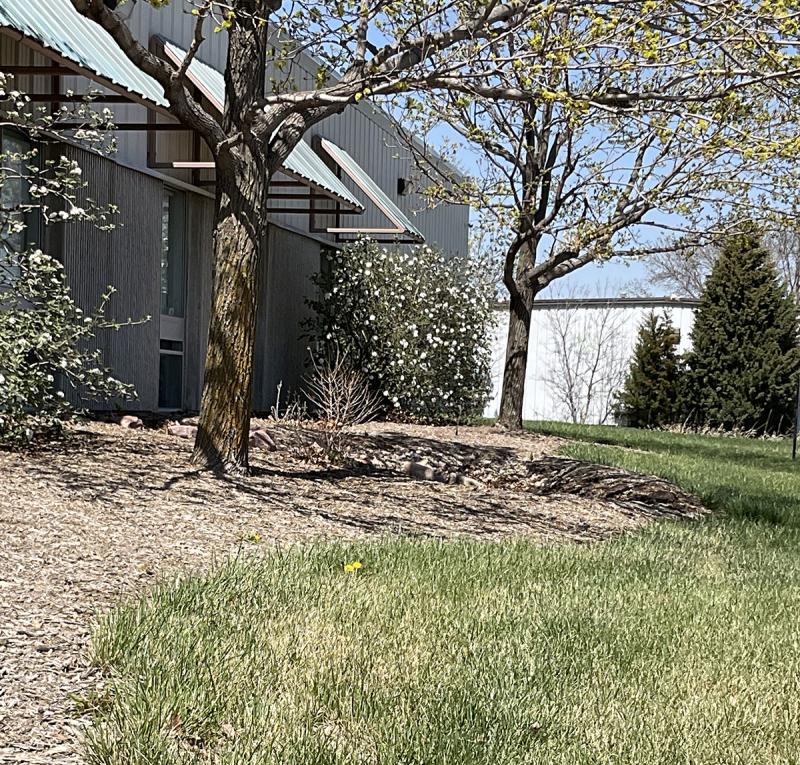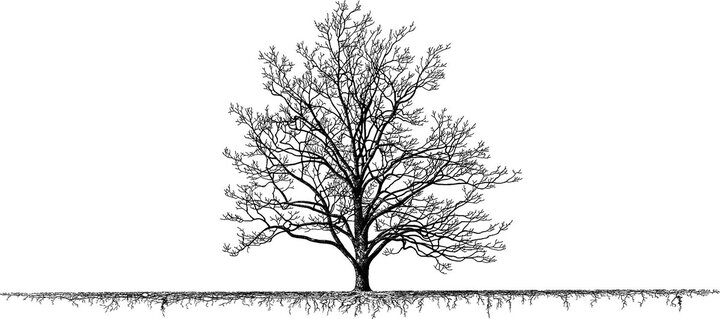Sarah Browning, Nebraska Extension Educator

Dry spring conditions. Image by Sarah Browning, Nebraska Extension Educator
Lancaster County ended 2022 under very dry conditions – approximately 11 inches below normal rainfall. Dry conditions continued throughout winter bringing us into spring with the entire state still experiencing drought. According to the U.S. Drought Monitor, Lancaster county is currently classified with “severe drought” conditions. To find the drought conditions for your location at any time throughout the year summer, visit droughtmonitor.unl.edu.
Is it Time to Water
These unusually dry conditions are making many home gardeners wonder if they should begin watering and, if so, how much? Before beginning to irrigate your landscape, consider these tips.
- Conditions are dry, but spring growth is just beginning. Plants are nowhere near the peak water usage normally experienced from late July through September. Watering multiple times each week right now is not recommended.
- Check your existing soil moisture. Dig up some soil and squeeze it in your hand. If the soil maintains a ball shape, then sufficient moisture may be present for shrubs and ornamentals.
- April and May are normally the rainiest months of our year and, hopefully, we will get more rain soon. Take any rainfall received into your calculations on the amount of irrigation needed by your landscape. Landscape plants, both trees and turf, need 1” of irrigation/rainfall per week to grow their best.

Best Watering Practices
In preparation for another potentially dry summer, before beginning to water this season first set watering priorities. What are the priority plants in your landscape and the most difficult – due to time or expense - to reestablish? It takes decades to establish a new tree to replace one killed or damaged by drought, while turfgrass can be reestablished in a few months. Shrubs and ornamentals plants usually fall somewhere in the middle. If your watering budget is limited, focus water on those plants which are your highest priority.
When irrigation is needed, water plants deeply, but infrequently. The goal is to keep your soil moist about ½ inch deeper than the deepest living roots or, if the root depth is unknown, to 8 or 9 inches into the ground.
The majority of turfgrass roots are 6-12 inches deep. Woody plant water-absorbing roots are deeper, typically 12 to 24 inches. Root systems of woody plants are also very wide, often going out a distance twice the height of the tree, measured from the trunk to the tip of the furthest root. At a minimum, focus on watering the roots beneath the tree’s dripline, the area from the trunk to the tip of the widest branch all around the tree.

Determine Moisture Depth After Watering
An easy method to figure out how deeply your irrigation water has penetrated the soil is by sticking a long-bladed screwdriver or other metal probe into the ground after irrigation. The probe should move fairly easily through moistened soil but will resist when it encounters dry soil.
Remove the probe from the soil and measure the depth of soil moistened. When pulled out of the ground, the probe should be moist- not dry or soggy wet. If your irrigation system is not applying enough water to reach the bottom of your plant roots, then adjust the zone run times or use the soak & cycle method described below.
The screwdriver technique can also be used to determine when watering is needed. After watering, wait until the soil gets drier and the probe is harder to push, then it’s time to water again.
Soak & Cycle
To encourage deeper water movement in the soil - especially if lengthening zone run times results in water runoff - then use a technique called soak & cycle. This technique is especially useful with in-ground irrigation systems, but can also be used with sprinklers.
Start by running the irrigation system as usual. Afterwards, measure how deeply the moisture has gone into the soil. Then if additional moisture penetration is needed, run the irrigation zones again in the same day. This will allow water to penetrate even deeper in the soil.
In case you didn’t catch it, the critical step to getting deeper water penetration is rerunning the irrigation system the same day. You can cycle through your irrigation zones as many times as needed to get the proper moisture penetration depth, then you won’t water again until the soil has dried out. Deep, infrequent irrigation is the best practice for growing deep healthy roots.
Maintain Soil Moisture for Woody Plants
To make the irrigation of your woody plants more effective, conserve soil moisture by applying a 3 to 6-foot diameter ring of mulch around the base of tree's and shrubs. Use 3-4 inches of an organic material, like coarse wood chips, to help conserve soil moisture. Apply the mulch in a wide, flat layer like a pancake, not piled up like a mulch-volcano. Keep it a few inches away from the tree's bark to prevent bark rots.
Final Tips
If your soil is dry now, start the season with one deep soaking irrigation. This can be applied in conjunction with your first fertilizer and/or preemergent herbicide application.
Use the screwdriver method to determine when to water again. Given the earliness of the season and relatively cool temperatures, watering now may only be needed once a week or once every couple weeks.
Resist the urge to water too often. Watering too frequently limits soil oxygen penetration and, when practiced long-term, causes root dieback in both turfgrass and woody plants.
Images
- Use a long-bladed screwdriver to check soil moisture and determine when to water again. Image by John Fech, Nebraska Extension.
- Water-absorbing tree roots are wide and shallow. Image from The Landscape Below Ground IV (G.W. Watson and D. Neely, Eds.) 1994. Landscape Below the Ground. http://landscape-below-ground.w.isa-arbor.currinda.com/
Search Our Archive
Associated Video
Watering Drought Stressed Trees and Shrubs
UNL East Campus Landscape Services Manager Jeff Culbertson demonstrates watering techniques to helping trees and shrubs survive drought.